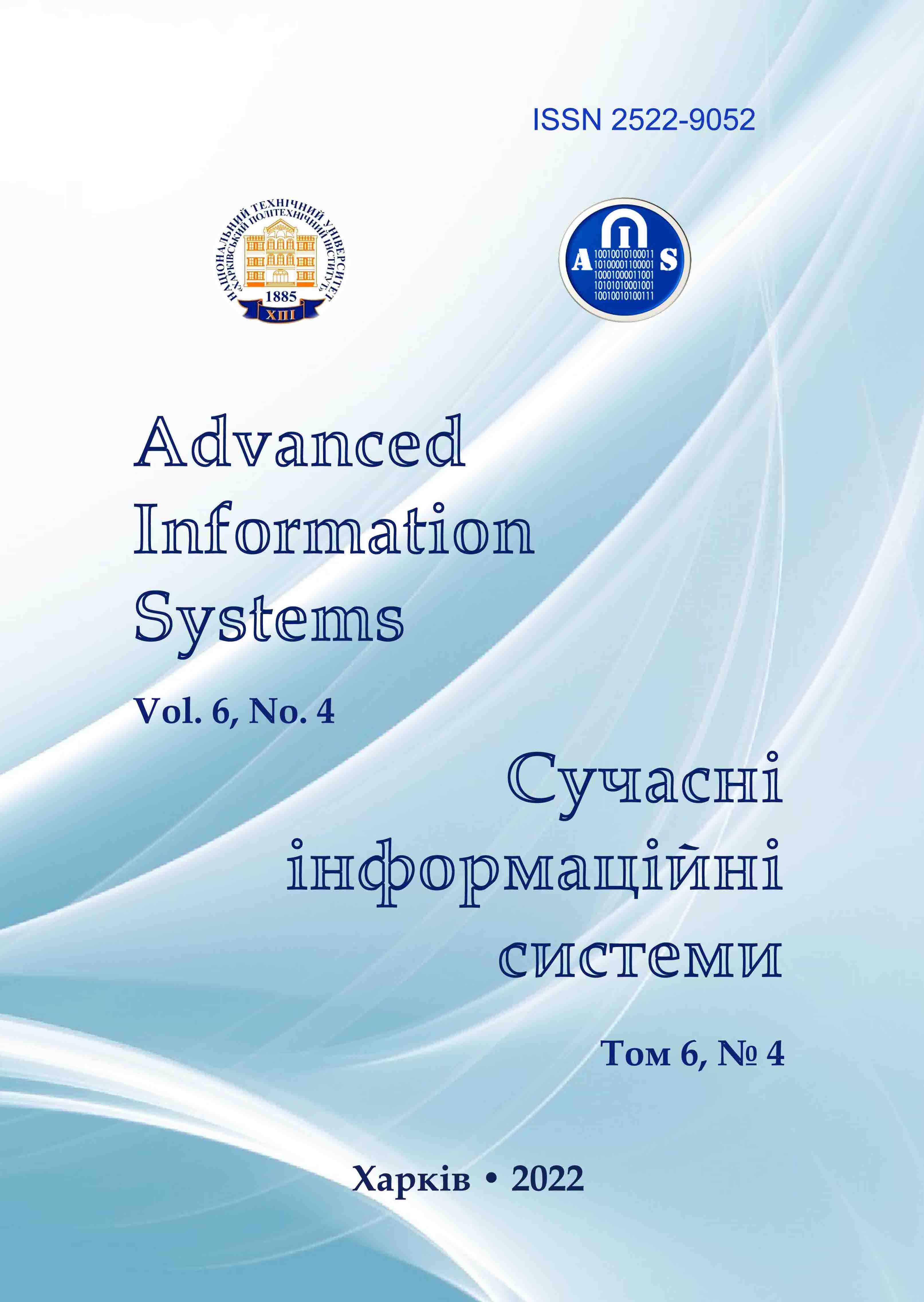COMPUTER SIMULATION MODEL OF A COMPUTER NETWORK WITH FRACTAL TRAFFIC FOR TESTING ROUTING ALGORITHMS
Main Article Content
Abstract
The object of research in this article is simulation modeling of a computer network and the process of traffic routing. The relevance of the research is due to the importance of ensuring the quality of service in computer networks, in particular, by necessity reducing the number of lost IP-packets at high traffic intensity values. Determining the routing of traffic packets is a complex process and is based on various indicators or combinations of indicators. If the routing process takes place in a dynamic mode, then the complexity of the route calculation increases, in this case, one of the tools for research and comparison of different routing algorithms can be a computer simulation model of a computer network. The goal of the work is the development and research of a computer simulation model of a computer network for testing traffic routing algorithms. The tasks: to develop computer simulation model of a computer network to generate the network structure and simulate the traffic distribution process with the ability to test different routing algorithms. Research methods: theory of computer networks, theory of fractal analysis, object-oriented programming, theory of algorithms and data structures, theory of complex networks, theory of Markov processes. Conclusions. The paper investigated the basic principles of traffic routing in computer networks. A simulation model of a computer network for testing traffic routing algorithms has been developed. A method based on the theory of complex networks has been developed to generate the structure of a computer network. Theory of fractal analysis and Markov processes are used for traffic generation. A series of experiments was conducted on a developed model to determine how different fractal dimensions of traffic at high traffic intensity values affect the number of lost packets, and therefore the quality of service. Analyzing the results of the experiment, the following conclusions can be drawn: the least number of lost packets occurs when the process is random or has weak trends. The fewest lost packets were at fractal dimension 1.5, i.e., when the process is completely random, there were also few lost packets at fractal dimensions close to this; persistent and anti-persistent processes (those with memory) cause more packet loss for the same traffic intensity and maximum number of packets sent from one device per unit of time. Moreover, anti-persistent processes cause significantly more losses than persistent ones. Thus, when performing traffic routing and finding optimal paths for sending IP-packets, it can be useful to determine and take into account the fractal dimension of traffic at the entrance of each router and use it when calculating metrics to determine the best routes.
Article Details
References
Barabási, A.-L. (2018), Network science, Cambridge University Press, 475 p., available at: http://networksciencebook.com.
Snarskyi, A.O. & Lande, D.V. (2015), Modeling Complex Networks: Tutorial, Engineering, Kyiv, 212 p., available at: http://dwl.kiev.ua/art/mss/ (in Russian).
Traag, V.A. (2014), Algorithms and Dynamical Models for Communities and Reputation in Social Networks, Springer International Publishing, 229 p., doi: https://doi.org/10.1007/978-3-319-06391-1.
Watts, D.J. & Strogatz, S.H. (1998), “Collective dynamics of “small-world” networks”, Nature, Vol. 393(6684), pp. 440-442, available at: https://www.nature.com/articles/30918.
Drieieva, H., Drieiev, O., Meleshko, Ye., Yakymenko, M. & Mikhav, V. (2022), “A method of determining the fractal dimension of network traffic by its probabilistic properties and experimental research of the quality of this method”, CEUR -WS, Vol. 3171, Gliwice, Poland, R. 1694-1707, available at: http://ceur-ws.org/Vol-3171/paper120.pdf.
Meleshko, Ye., Drieiev, O., Yakymenko, M. & Lysytsia, D. (2020), “Developing a model of the dynamics of states of a recommendation system under conditions of profile injection attacks”, Eastern-E doi: https://doi.org/10uropean Journal of Enterprise Technologies, Vol. 4, No. 2(106), pp. 14-24, doi: https://doi.org/10.15587/1729-4061.2020.209047.
Meleshko, Ye., Raskin, L., Semenov, S. & Sira, O. (2019), “Methodology of probabilistic analysis of state dynamics of multi-dimensional semi-Markov dynamic systems”, Eastern-European Journal of Enterprise Technologies, Vol. 6, No. 4(102),
pp. 6-13, doi: https://doi.org/10.15587/1729-4061.2019.184637.
Dimitrakos, T.D. & Kyriakidis, E.G. (2008), “A semi-Markov decision algorithm for the maintenance of a production system with buffer capacity and continuous repair times”, International Journal of Production Economics, Vol. 111(2), pp. 752-762, doi: https://doi.org/10.1016/ j.ijpe .2007.03.010.
Li, Q.-L. & Lui, JCS, (2014), “Block-structured supermarket models”, Discrete Event Dynamic Systems, Vol. 26(2), pp. 147-182, doi: https:// doi.org/10.1007/s10626-014-0199-1.
Okamura, H., Miyata, S. & Dohi, T., (2015), “A Markov Decision Process Approach to Dynamic Power Management in a Cluster System”, IEEE Access, Vol. 3, pp. 3039-3047, doi: https://doi.org/10.1109/access.2015.2508601.
Li, Q.-L. (2016), “Nonlinear Markov processes in large networks”, Special Matrices, Vol. 4(1), doi: https://doi.org/10.1515/spma-2016-0019.
Feinberg, E.A. & Yang, F. (2015), “Optimal pricing for a GI/M/k/N queue with several customer types and holding costs”, Queuing Systems, Vol. 82(1-2), pp. 103-120, doi: https://doi.org/10.1007/s11134-015-9457-7.
Olifer, N. & Olifer, V. (2005), “Computer Networks: Principles”, Technologies and Protocols for Network Design 1st Edition, Wiley, 1000 p.
Cisco (2022), “IP Routed Protocols”, available at: https://www.cisco.com/c/en/us/tech/ip/ip-routed-protocols/index.html.
Barabási, A.-L. & Albert, R. (1999), “Emergence of scaling in random networks”, Science, Vol. 286, No. 5439, P. 509-512, doi: https://doi.org/10.1126/science.286.5439.509.
Drieieva, H., Smirnov, O., Drieiev, O., Polishchuk, Y., Brzhanov, R. & Aleksander, M. (2020), “Method of Fractal Traffic Generation by a Model of Generator on the Graph”, COAPSN, CEUR-WS, Vol. 2616, Lviv, Ukraine, available at: http://ceur-ws.org/Vol-2616/paper31.pdf.
